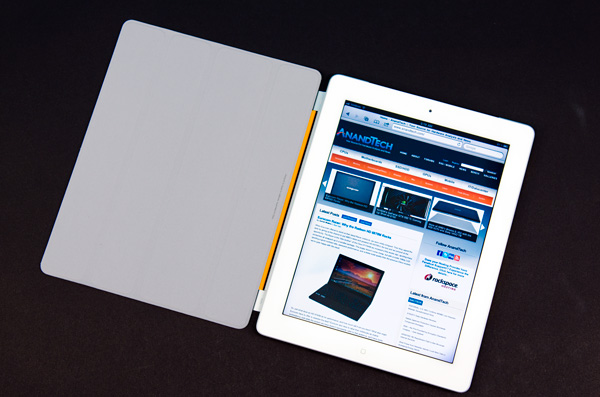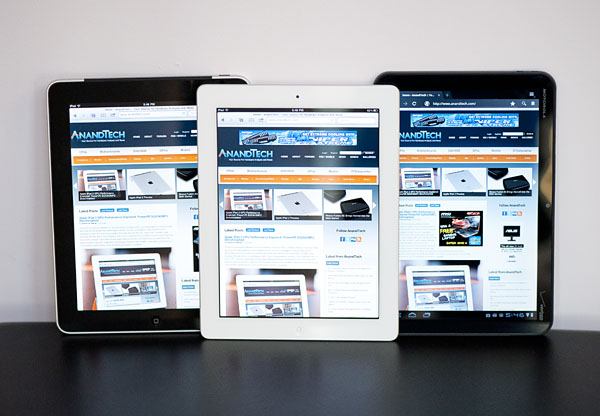The Apple iPad 2 Review
by Brian Klug, Anand Lal Shimpi & Vivek Gowri on March 19, 2011 8:01 PM ESTFinal Words
If you fell in love with the original iPad, the iPad 2 is a significant upgrade. You get much faster hardware, a much more ergonomic device and the ability to FaceTime with your friends. If it weren't for the fact that the iPad 3 is likely 12 months away with another set of similarly impressive upgrades I'd recommend all iPad users upgrade to the 2nd generation model.
I find that with Apple products you have to pick an upgrade cadence and firmly stick to it. In the Mac world it's difficult but not too hard to stick to. Upgrading yearly never makes financial sense so usually putting yourself on a 2 - 3 year cycle for the biggest upgraders usually works. Apple hardware tends to hold its value surprising well so as long as you do a good job of reselling your old stuff, this cadence can work well if you absolutely must have the latest and greatest.
The iOS platforms are a bit more difficult to be patient with. As you can see by the SoC upgrades Apple has thrown into the iPad 2, for the next couple of years you should expect Apple to be upgrading at a rate faster than Moore's Law. Eventually this will level off but for the iPad 2, iPad 3 and probably even the iPad 4 we'll see this sort of aggressive ramp in hardware capabilities. You really have to treat the iPad like a smartphone - it's going to be made significantly less desirable in about 12 months so plan your purchasing accordingly.
Cautious purchasing brings me to my biggest complaint about the iPad 2 - its pricing. Motorola gets a bad rap for pricing the first Xoom at $799, but there's only one iPad 2 that sells at $499. Buy a case, pick one of the higher capacity models, add 3G and you're quickly paying a lot more for the iPad 2 than you would a mainstream PC. Granted Apple doesn't make as much off of the iPad as it does other members of its product lineup, but I still feel the price is too much for a device that can only augment your existing computing devices.
I do wish Apple was able to increase display resolution on the iPad 2, although I suspect that combined with the SoC improvements that may have been a little too much for this generation. It's clear that a higher resolution panel is coming as Apple finally has an OS that properly handles DPI scaling. The real question is when, and is that time soon enough that you can hold off buying an iPad until then?
There's no better place to say this so I'll just put it out there: Apple's commitment to increasing performance deserves serious recognition. Whether or not you like the company, Apple outfitted the iPad 2 with a pair of ARM Cortex A9s and a GPU significantly faster than anything else on the market. Look around and you won't see many apps that can really stress the PowerVR SGX 543MP2 that Apple put in the A5. Make no mistake, this is about building a big install base of high performance mobile devices. Apple is eager to win the hearts of game developers with the A5. Gaming will be an important part of the tablet's evolution and Apple clearly understands that. What happens when your tablet is fast enough to run Halo? Performance matters here, maybe not as much today, but when the entire install base has PowerVR SGX 543MP2s at the bare minimum things will get really interesting.
Apple's fat trimming really improved the iPad 2's ergonomics, and the smart covers only helped improve things. While I wouldn't consider porting the original iPad around due to its limited usefulness in my workflow, the iPad 2 is thin and light enough where I'm less bothered by it. Ultimately I feel like tablets (iPad or not) have to be even thinner and even more ergonomic to really come into their own. The good news is that Apple hasn't done anything too exotic in slimming down the original iPad. I'd expect the second generation of Android tablets to be similarly thin/light.
And that brings us to the controversy, the Honeycomb comparison. The Xoom is the only real competition shipping for the iPad 2 today, but within 60 days we'll likely have competitors from ASUS and Samsung on the market as well. Honeycomb has some serious advantages in the feature department. Multitasking is better under Android 3.0, as are notifications and as of yesterday there's finally Flash support. Apple still provides a smoother UI than Honeycomb, however this time around I'm wondering how much of that might be due to the GPU horsepower behind Tegra 2. While Tegra 2 does well on a lower resolution screen, I feel like it is underpowered to deal with the Xoom's 1280 x 800 display.
Hardware-wise Apple has an ergonomics advantage over the Xoom. While I like holding the Xoom more than the original iPad, I prefer the iPad 2's feel to the Xoom. The Xoom has the edge in camera quality and display resolution, while the iPad 2 has a better looking display and a faster GPU. I still fundamentally believe that web browsing and email are the killer apps for tablets and as such I don't put too much weight in Apple's iPad app advantage. Long term I believe that the most important apps will be available on both platforms, so unless there's an app that you want today that's an iOS exclusive I wouldn't lose sleep over it.
So if you're actually torn between the iPad 2 and the Xoom my best advice is to wait. Apple needs to update iOS in a major way and Honeycomb needs a hardware update. Whichever gets it right first should get your money.
If you don't fall into the borderline camp then the decision is pretty simple. If you need a tablet that runs iOS today, the iPad 2 is great. If you're not sure, you should wait. Tablets are still a couple of generations from being really amazing. Everything between now and then are just steps along the way.














189 Comments
View All Comments
Azethoth - Monday, March 21, 2011 - link
No! 22 seconds is not fast enough. That is 20 seconds wasted each time you do that in a day.benonemusic - Monday, March 21, 2011 - link
Excellent writing and content as usual. As a longtime reader (this is my first post) with an editorial eye, I had a suggestion for future articles such as this with multiple authors but in which the main review is written in the first person singular. It was slightly disorienting to see three authors (Brian, Anand, Vivek) but then much of the article written with "I" (presumably Anand), you might want to avoid listing all three authors as "ands" in that case. One idea would be make the first author the one who is speaking in the first person voice (presumably Anand in the case) and the other two to be listed as "with." If the review is written as "we" then having all three of the authors as "ands" makes sense. There are multiple solutions. You can simply keep the "ands" and then indicate who the "I" is in the first instance. You could obviously say "one of us" in the first instance and indicate "Anand" in parentheses. And so on. Sorry for going on this long, but I'm big on bylines. Keep up the great work with the articles!embeddedGPU - Monday, March 21, 2011 - link
Can you clarify the floating point precision for your GPU GFLOPS figures ? You mention 20-/32-bit for nVidia, but I think the SGX is only 16-bit precision. If so, it's not a totally fair comparison...wellortech - Monday, March 21, 2011 - link
"If you fell in love with the original iPad, the iPad 2 is a significant upgrade."Really? Since when is thinner and a crappy camera a significant upgrade?
mcnabney - Monday, March 21, 2011 - link
You guys missed noticing something when documenting the huge step forward with the iPad2 GPU power.We now have iOS fragmentation.
The entire iPad1 generation was obsoleted in the graphics department. Now developers have to choose between writing for the iPad1 or iPad2. There is far too large of a gulf between the two platforms. To benefit from the GPU advancement, the massive installed base of the iPad1 will have to be written-off.
kmmatney - Monday, March 21, 2011 - link
I don't think this is true. First, we are only talking about 2 models, and second, they can just enable more graphics features for iPad 2. I can see where some truly advanced games might only be written for the iPad 2 in the future, but there is really no way to avoid that.Azethoth - Monday, March 21, 2011 - link
There always was and always will be iOS fragmentation since the 2nd iDevice shipped.As for what it means in a practical sense: check out Infinity Blade on multiple devices (iPhone and iPad). See, not a big deal, content providers are used to scaling artwork and design.
Furthermore, iOS will suffer less from this than Android (fewer device specs). It is one of the aspects of the competition at this form factor that makes me think that Apple will do better than it does at the PC level. (Not that Apple PC profits are not insanely good for their industry: over 50% of entire industry by some accounting).
araczynski - Monday, March 21, 2011 - link
if you're after a notebook/pc replacement, you're kidding yourself with any tablet.if you're after a gaming device, you're golden :) especially if you think gaming on phone sized screens (this includes psp/ds/etc) is plain stupid.
mine is filled to the brim with games, no room for audio/video/etc, just pure games.
i love it, my daughter loves it, even my technophobe wife loves it.
its for entertainment, nothing more.
Azethoth - Monday, March 21, 2011 - link
It is for more than entertainment:You can amuse your cat with it as well!
coolio68 - Monday, March 21, 2011 - link
Great review Anand,regarding this comment though:'The real competition for the SGX 543MP2 will be NVIDIA's Kal-El. That part is expected to ship on time and will feature a boost in core count: from 8 to 12. The ratio of pixel to vertex shader cores is not known at this point but I'm guessing it won't be balanced anymore. NVIDIA is promising 3x the GPU performance out of Kal-El so I suspect that we'll see an increase in throughput per core.'
Worth bearing in mind a couple of things:
SGX 543MP can already incorporate 2 to 16 cores
The even higher performance SGX 554MP cores have also been announced in December
Power VR Series 6 (Rogue), the next-generation, can scale from 210 GFLOPS to 8 TFLOPS , and is already licensed by the usual suspects.
The A9600 chip announced by ST-E at MWC ,containing Rogue, is sampling in H2 2011.
Nvidia are gonna have their work cut out methinks, but the competition is great for the industry and consumers.